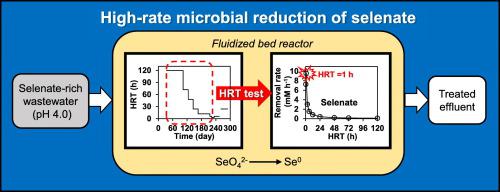Science of the Total Environment ( IF 9.8 ) Pub Date : 2020-09-14 , DOI: 10.1016/j.scitotenv.2020.142359 Su Yan , Ka Yu Cheng , Maneesha P. Ginige , Guanyu Zheng , Lixiang Zhou , Anna H. Kaksonen

|
Wastewater contaminated with high concentrations of selenium oxyanions requires treatment prior to discharge. Biological fluidized bed reactors (FBRs) can be an option for removing selenium oxyanions from wastewater by converting them into elemental selenium, which can be separated from the treated effluent. In this study, a lab-scale FBR was constructed with granular activated carbon as biofilm carrier and inoculated with a consortium of selenate reducing bacteria enriched from environmental samples. The FBR was loaded with an influent containing ethanol (10 mM) and selenate (10 mM) as the microbial electron donor and acceptor, respectively. The performance of the FBR in reducing selenate was evaluated under various hydraulic retention times (HRTs) (120 h, 72 h, 48 h, 24 h, 12 h, 6 h, 3 h, 1 h and 20 min). After process acclimatization, selenate was completely removed with no notable selenite produced when the HRT was stepwise decreased from 120 h to 6 h. However, decreasing the HRT to 3 h resulted in selenite accumulation (0.17 ± 0.023 mM) in the effluent although selenate removal efficiency remained at 99.8 ± 0.20 %. At 1 h HRT, the FBR removed 90.8 ± 1.4 % of the selenate at a rate of 9.6 ± 0.15 mM h-1, which is the highest selenate reduction rate reported in the literature so far. However, 1 h HRT resulted in notable selenite accumulation (up to 2.4 ± 0.27 mM). Further decreasing the HRT to 20 min resulted in a notable decline in selenate reduction. Selenate reduction recovered from the “shock loading” after the HRT was increased back to 3 h. However, selenite still accumulated until the FBR was operated in batch mode for 6 days. This study affirmed that FBR is a promising treatment option for selenate-rich wastewater, and the process can be efficiently operated at low HRTs.
中文翻译:

在上流厌氧流化床反应器(FBR)中高速率去除硒酸盐
被高浓度含氧阴离子硒污染的废水需要在排放前进行处理。生物流化床反应器(FBR)是将废水中的硒氧阴离子转化为元素硒的一种选择,该元素可以从处理后的废水中分离出来。在这项研究中,实验室规模的FBR用颗粒状活性炭作为生物膜载体构建,并接种了从环境样品中富集的硒酸盐还原菌。FBR装有分别含有乙醇(10 mM)和硒酸盐(10 mM)作为微生物电子给体和受体的进水。在各种水力停留时间(HRT)下(120小时,72小时,48小时,24小时,12小时,6小时,3小时,1小时和20分钟)评估了FBR还原硒酸盐的性能。经过过程适应之后,当HRT从120h逐步降低到6h时,硒酸盐被完全除去,没有明显的亚硒酸盐产生。但是,将HRT降低至3 h会导致亚硒酸盐在废水中积聚(0.17±0.023 mM),尽管硒酸盐的去除效率仍保持在99.8±0.20%。在HRT 1 h时,FBR以9.6±0.15 mM h的速率去除了90.8±1.4%的硒酸盐-1,是迄今为止文献中报道的最高硒酸盐还原率。但是,HRT 1 h导致亚硒酸盐明显聚集(高达2.4±0.27 mM)。将HRT进一步降低至20分钟会导致硒酸盐还原量显着下降。HRT增加到3小时后,硒酸盐的减少从“冲击负荷”中恢复。但是,亚硒酸盐仍会累积,直到FBR以批处理模式运行6天。这项研究肯定了FBR是富含硒酸盐废水的一种有前途的处理选择,并且该工艺可以在低HRT的情况下有效运行。



























 京公网安备 11010802027423号
京公网安备 11010802027423号